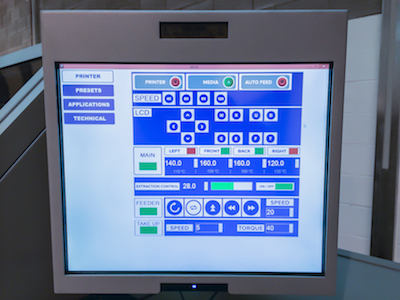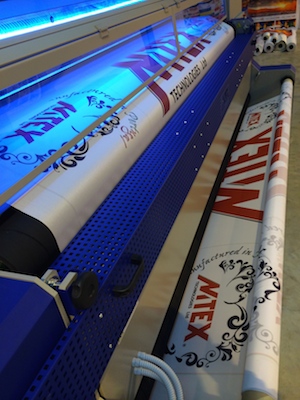Nessan Cleary asked users for their take on this all-in-one textile printer aimed squarely at the graphics market.
In recent years there have been quite a number of textile printer launches, mainly due to the growth in the garments and home furnishings markets. But there has also been movement in the soft signage market with textile printers producing flags and exhibition graphics as well as outdoor banners. But printing to fabrics is not quite as straightforward as with other substrates and many textile printers are designed to print to transfer paper first, necessitating a heat press for the actual sublimation - and the prints will also require fixation so they can be washed without the inks disappearing.
The Portuguese company Pod has carved out a good reputation for its distinctive blue Mtex textile printers, which are distributed in this country by DPI. These include the 3.2m wide Mtex 5032, which offers graphics companies a relatively easy-to-use solution that prints direct to fabric and comes complete with fixation.
This month we’ve spoken to a couple of companies that have invested in these printers. London-based Genix Imaging prides itself on being a multi disciplinary agency that mainly serves the retail sector. The company operates a range of wide-format printers, including aqueous, solvent, latex and UV, and has now added textile printing in the shape of a 3.2m wide machine from Mtex.
Genix Imaging director Andrew LeMaire says there’s a growing interest in soft signs so the company saw a gap in the marketplace, adding: “Apart from anything else, the application and distribution, as well as the image quality has got a lot better.”
LeMaire says that Genix looked at different options but felt that although the Mtex wasn’t the cheapest machine it was the best fit for its needs, explaining: “It’s down to the imaging quality, plus it is an inline calendar solution so you don’t have to have two separate machines which enables you to do test prints more easily as you can run a small amount of media by way of a colour test. Most of our clients are quite high-end so the colour is quite critical.”
Another advantage of having an integrated machine is that it takes up less space, as LeMaire stresses: “Space in a manufacturing area is important so you try to get equipment that needs a smaller footprint.”
There have been no major issues with the printer at Genix, other than the normal teething problems, which Mtex were able to sort out. But LeMaire adds: “We have been on a massive learning curve because you get shrinkage at different rates with different media and then when you mount it you get stretching with different materials at different rates.”
Genix has no plans to use the textile printer for garments or soft furnishings, areas so often highlighted as growing markets. Instead the company is using it for its retail customers’ display signs. LeMaire adds: “Hopefully it will help to open our client base in the exhibition side.”
Cover-up, based in Dublin, is the first company in Ireland to buy one of these Mtex printers and reports a similar experience. This company, which was founded in 1970, mainly produces flags but is also seeing growth in indoor signage as well as POP and marquees. Manager Anthony Byrne says that companies are also increasingly buying aluminium extrusion frames so that they can replace the graphics easily using fabric prints. Byrne is adamant that the company will continue to specialise in advertising – and again it has no plans to produce garments or furnishings.
Cover-up bought its Mtex 5032 printer at the start of this year. Byrne says the company had used two 1.8m wide dye-sub printers for several years, but needed something larger. He explains: “A lot of the work was becoming 2m and 2.5m so we decided to expand to keep the work. It's just a natural progression. The other reason was that the technology was getting a bit older, so we needed to get better quality prints from the machine.” He says the Mtex machine is a little bit faster than his previous machines but it was mainly the wider prints and improved image quality that he was after.
Byrne says the printer is easy to maintain and doesn't require much attention, which he puts down to the use of water-based inks.
 The built-in calendar unit of the Mtex 5032 was another reason why Cover-up went with this model. Byrne explains: “We looked at going down the route of an external calendar but it was just not our thing. Sometimes we need to turn jobs around very quickly and also a separate calendar would have taken too much space.”
The built-in calendar unit of the Mtex 5032 was another reason why Cover-up went with this model. Byrne explains: “We looked at going down the route of an external calendar but it was just not our thing. Sometimes we need to turn jobs around very quickly and also a separate calendar would have taken too much space.”
The company has its own in-house finishing, including high frequency welding so with the prints coming off the Mtex 5032 already fixed, jobs can be turned around fairly quickly. Indeed the only issue he has had has been with the amount of shrinkage, caused by the direct heat of the fixation unit. Byrne notes: “Most of the time it doesn't matter but if you have text very close to the edge then you have to think about it.”
Both Genix and Cover-up have encountered a steep learning curve to deal with the issue of shrinkage, but both say they were warned about this and that there were no hidden surprises when using this printer. Instead they each have used the size of the machine to help them expand their offering.
About the product
Pod makes a number of textile printers, all sold under the Mtex brand name. There’s a choice between 1.8 and 3.2m widths, with different models designed to cope with different types of fabrics.
The Mtex 5032 is a 3.2m wide textile printer that’s suitable for most graphics applications from flags to backlits. It uses Epson printheads, and resolution ranges from 540dpi to 1440dpi, while it prints at up to 58m2/hr.
It prints in four colours (CMYK) with aqueous dye sublimation disperse inks that are suitable for polyester fabrics. It’s fitted with an electro-pneumatic feeding system to keep the media at the correct tension, regardless of the substrate in use.
It prints direct to fabric and has a built-in infrared fixation unit to fix the prints so that the resultant flags, banners and so on can be washed without the inks fading.
Alternatives
There are quite a number of textile printers around, but only a handful that can print direct to textile across a 3.2m width, include a fixation unit and are designed for graphics rather than producing garments or furnishings. \
HOLLANDERS
Perhaps the most obvious competitor is Hollanders, which makes the Colorbooster series, including the 3.2m wide XL model. This uses a high energy disperse dye-sub ink which Hollanders claims gives a very wide colour gamut with an intense black. It has a modular approach in that the basic model has two sets of four Epson heads, but it can be field upgraded to two sets of six Seiko heads so that the printer can be quite closely tailored to a specific requirement.
AGFA
Agfa has been a relatively recent entrant to this field with its Ardeco printer. This is a 3.2m wide machine, that uses Ricoh printheads, with a choice of eight or 12 printheads. Agfa quotes speeds of up to 137m2/hr with a 600 x 600dpi resolution.
Naturally Agfa supplies its own disperse dye-sub inks and the printer can cope with highly absorbent and open-weave fabrics such as meshes thanks to an ink-through feature. There’s also an optional inline cold-knife cutting system. It comes supplied with Agfa’s Asanti Rip.
{jathumbnail off}


